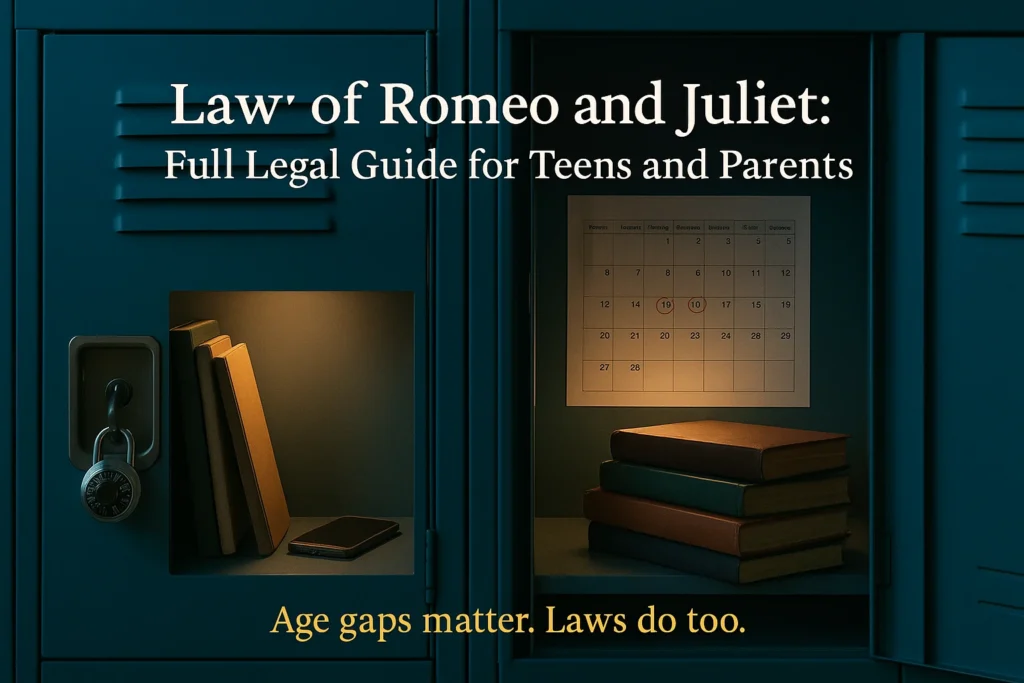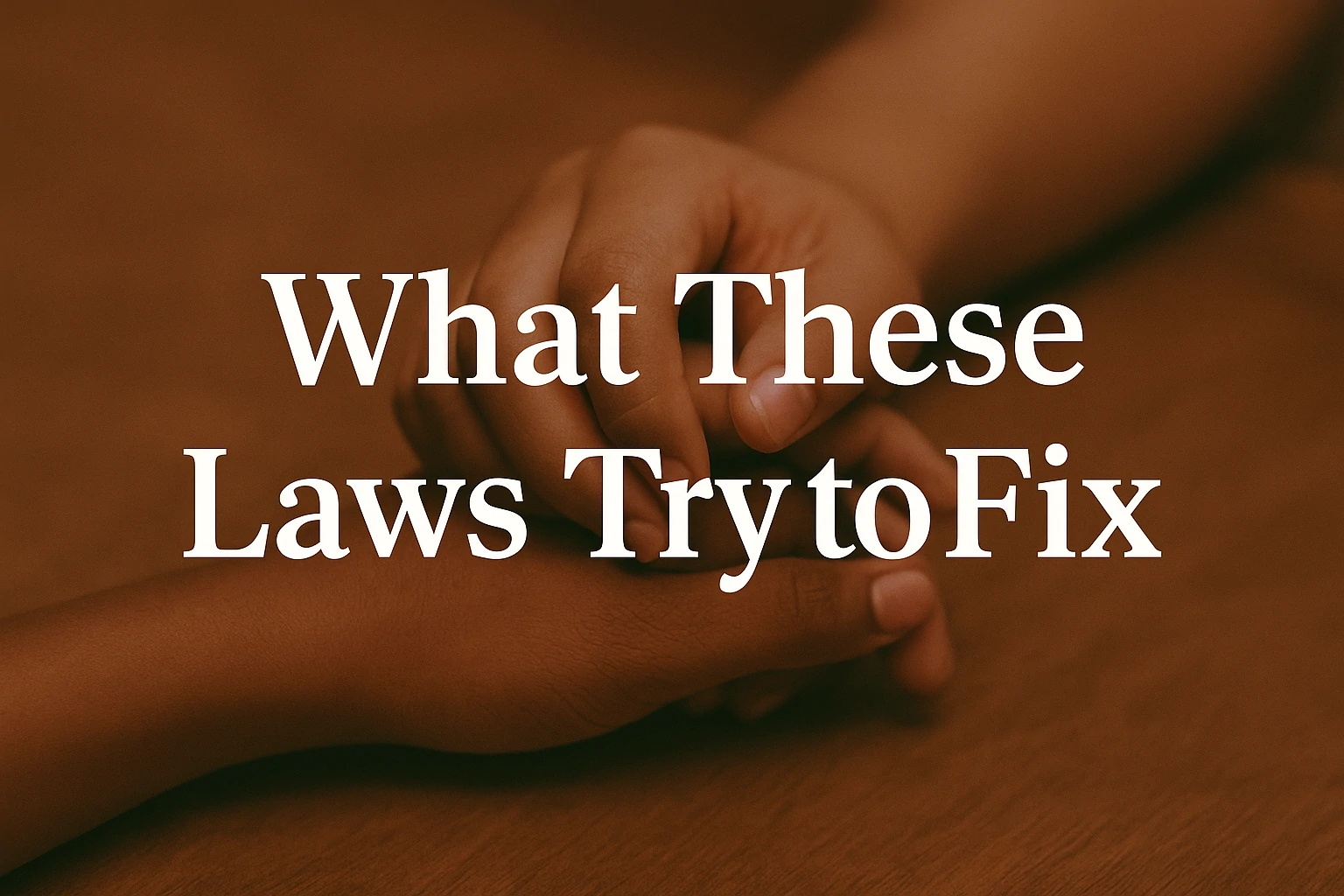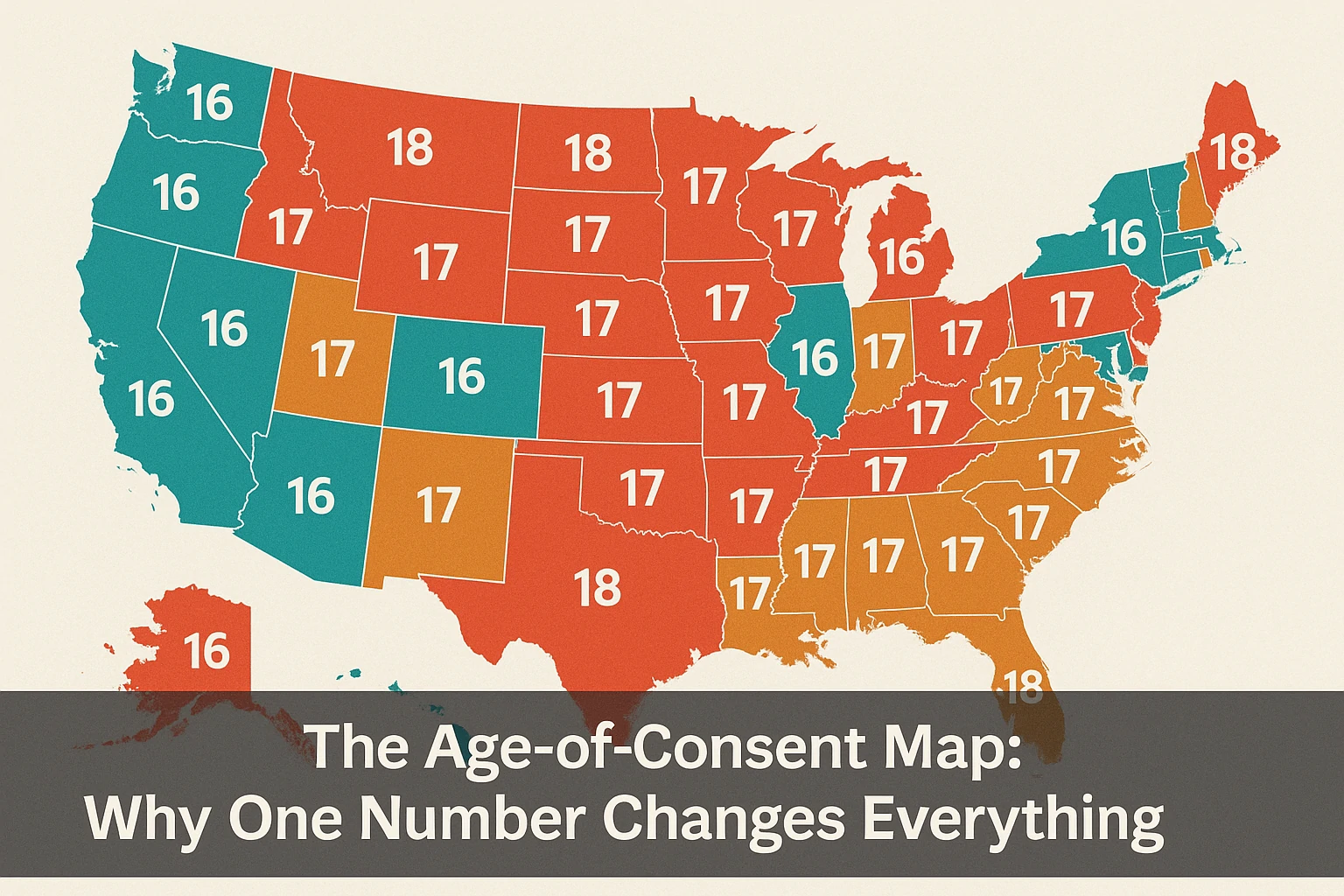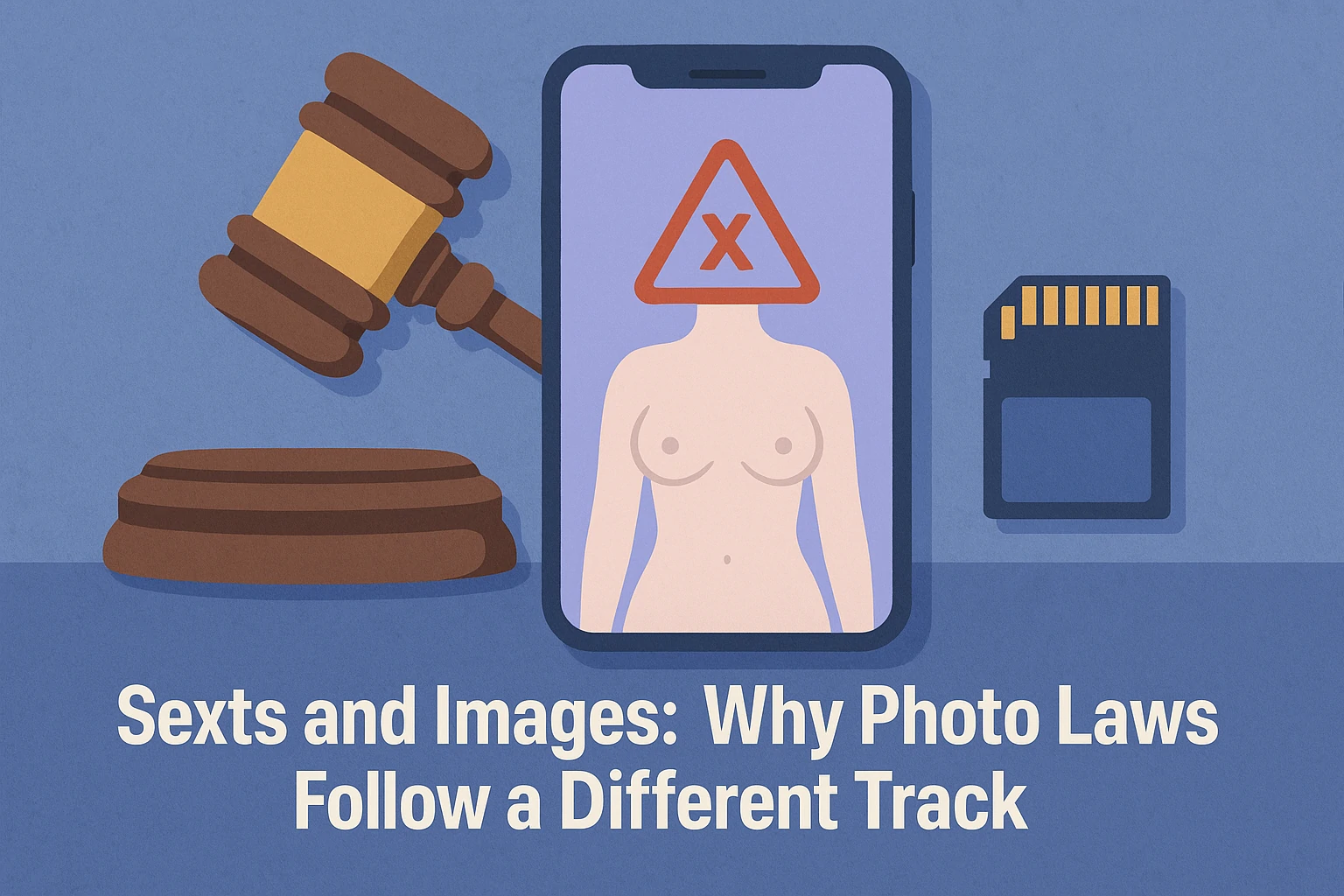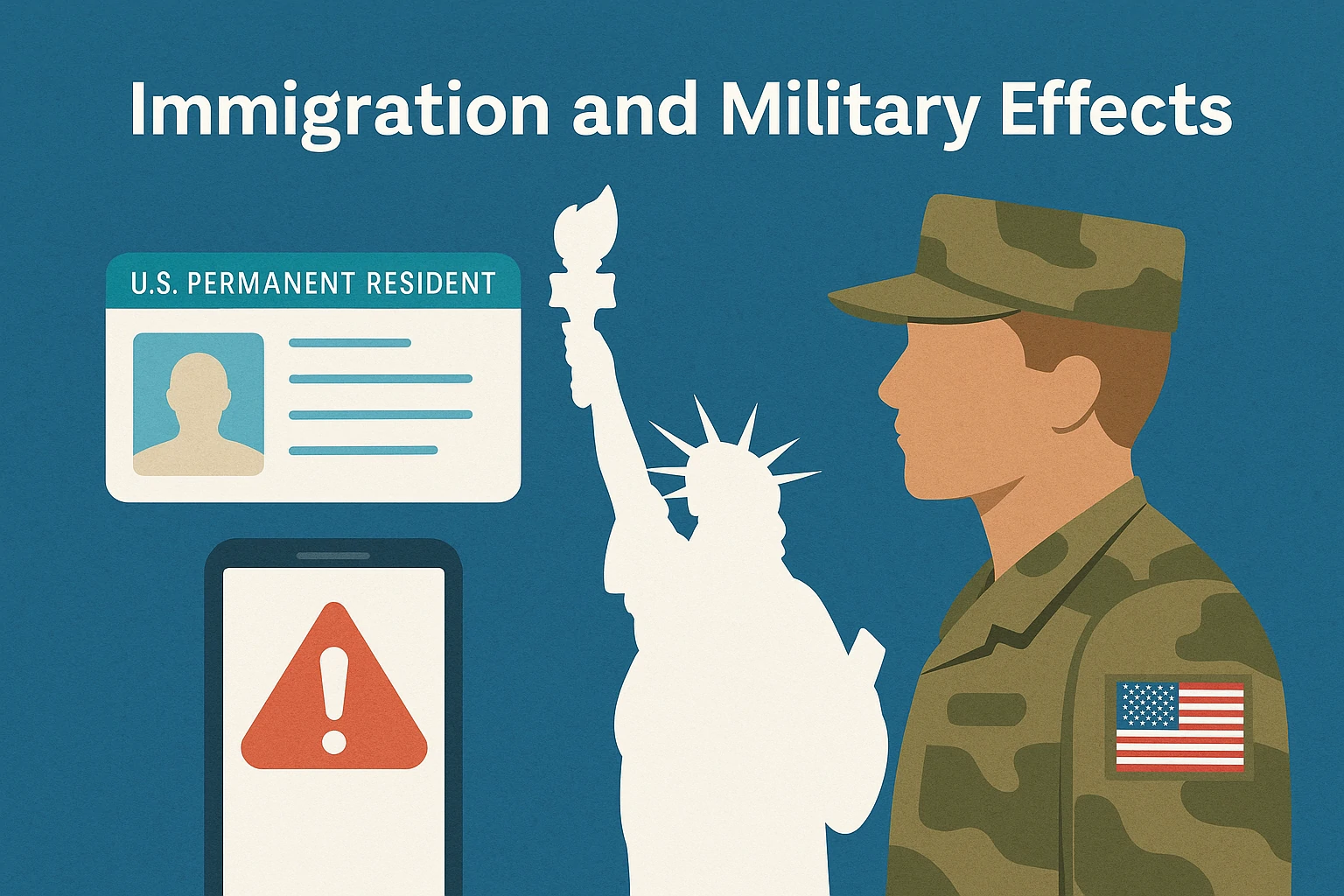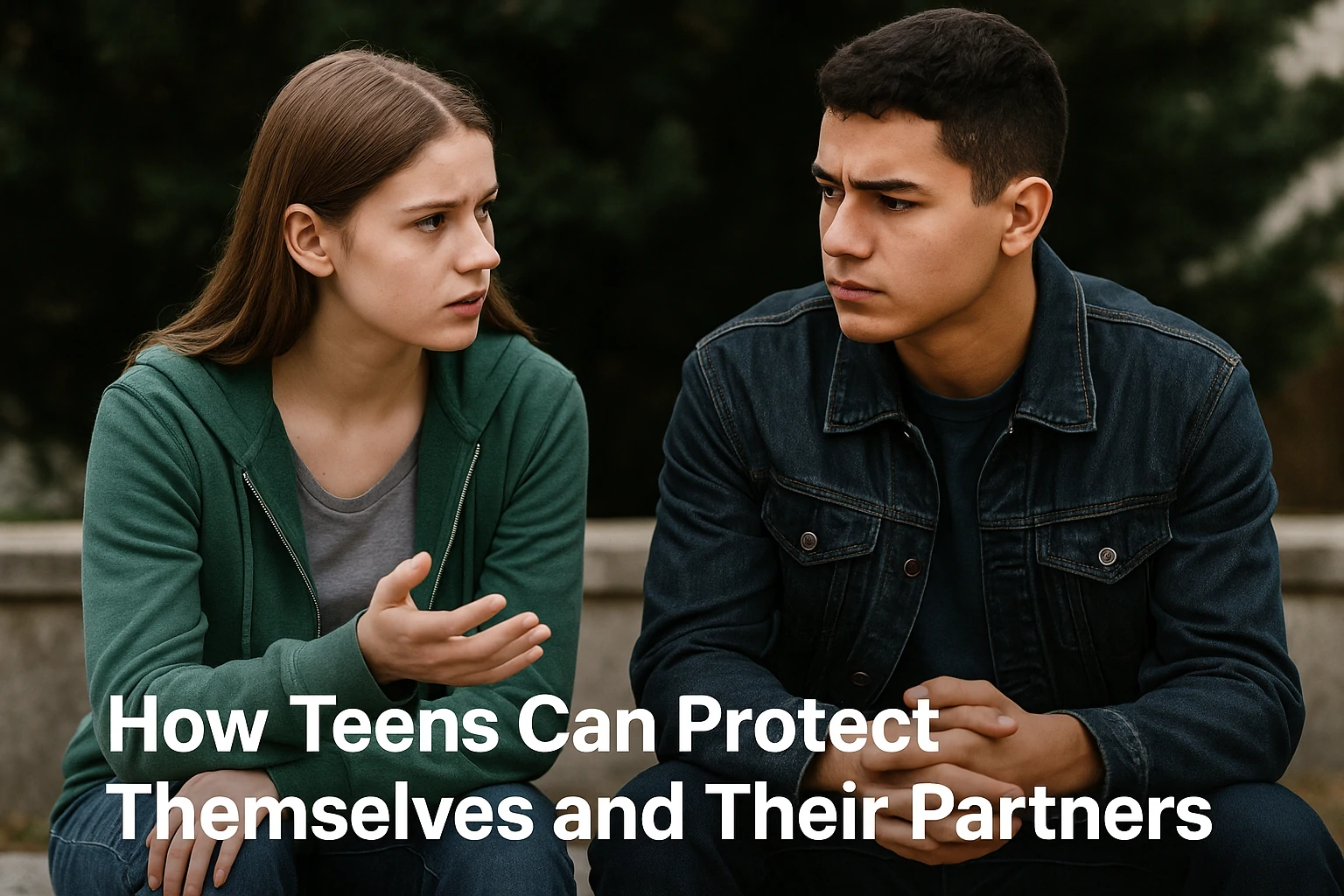Teen relationships cause worry in many homes. Parents want clear rules. Teens want trust and fairness. Courts want a just outcome that fits the facts.
The phrase “Romeo and Juliet law” sits in the middle of that tension. People hear it on TV or see it online. Many think it means teen sex is legal. That is not true.
The real idea is narrow and precise. It deals with close-in-age partners. It limits harsh results in some cases. It does not excuse abuse.
You need plain language on this topic. You deserve examples that make sense. You want to know how police, schools, and courts treat close-in-age relationships.
You also want to see how small details change outcomes. The age gap matters. The age of consent matters. Power or trust roles matter.
Digital photos and texts matter. Each fact pulls the law in a new direction. A small change can flip a case from a felony to a lower offense. The same change can also remove a defense.
This guide explains all of that in clear steps. You will see what these laws do. You will also see what they do not do. You will learn the terms that officers, lawyers, and judges use.
You will read what parents can do to reduce risk. You will get ideas on how teens can set safe rules in their own lives. The goal is simple. Help you protect your family. Help young people grow with care. Help the law meet real life in a fair way.
What “Romeo and Juliet Law” Means in Plain English
Many states use close-in-age rules. People call these rules “Romeo and Juliet laws.” The label is not formal. Statutes rarely use the phrase.
The rules try to prevent extreme punishments when two young people date with consent and the age gap stays small. Lawmakers saw that some teen couples face felony charges that do not fit the facts. These rules aim to fix that.
A close-in-age rule can work in two ways. It may reduce a charge from a felony to a lower offense. It may block a charge when both partners fit narrow ages.
Some states tie the rule to sex offender registration. A judge may waive or limit that duty when the facts show a close-in-age, consensual case. Other states do not allow a waiver. Each state draws lines in a unique way.
These laws do not authorize sex with minors. They only soften the outcome in some cases. Courts still ask hard questions. Was the contact consensual?
Did one person hold power over the other? Did coercion exist? Did threats exist? If the answer is yes to any of those, a close-in-age rule usually fails. Evidence decides these cases. Facts rule the day.
Key Terms You Must Know
Legal words can feel heavy. These short notes will help you track the rules and read a statute with more confidence.
Age of consent. This is the age at which a person may lawfully agree to sexual contact. This age differs by state. Some states use 16. Some use 17. Some use 18. The number sets the baseline.
Close-in-age exemption. This rule softens penalties when partners are near in age. The gap may be two years, three years, or another set span. The gap can also change with the younger partner’s age. You must read the exact statute.
Position of trust or authority. Teachers, coaches, clergy, guardians, and similar roles fall here. Many states remove any close-in-age defense if one partner holds power over the other. Power changes consent. The law knows this and reacts to it.
Strict liability. Some statutes do not allow a “mistake of age” defense. If the partner is under the legal age, the offense exists. Belief about age does not matter in those laws.
Sex offender registration. Some close-in-age statutes allow a judge to waive or end the duty to register. Other states mandate registration even in close-in-age cases. The record can shape work, school, and housing for years. This detail matters a lot.
What These Laws Try to Fix
The main aim is proportional justice. The state wants to punish real harm and block abuse. The state also wants to avoid life-long labels for teen couples who act with consent.
Lawmakers saw cases where a 17-year-old and a 15-year-old faced a felony and mandatory registration. That felt wrong to many voters and judges. Close-in-age rules try to keep the system fair.
The second aim is clarity. Broad laws can sweep in harmless cases. Narrow safe harbors give families a clear rule. If both partners meet the age lines and the gap is small, the rule cuts charges or penalties.
If the facts fall outside the lines, the rule does nothing. This frame helps police make charging calls. It helps prosecutors weigh the facts. It helps defense lawyers give accurate advice.
A third aim is prevention. When teens and parents know the rules, they plan better. Teens can avoid risky gaps. Parents can set curfews and tech rules that match the law. Schools can teach consent with real dates and numbers. Good policy starts with good facts. These laws push that idea.
What These Laws Do Not Do
They do not legalize sex with minors. They do not bless large gaps. They do not excuse pressure or threats. They do not protect any act where one person holds power over the other.
They do not erase all records. They do not stop civil orders like protective orders. They do not block school discipline. You must hold that list in mind. Many people get this wrong and face shock later.
They do not apply to every act. A rule may cover intercourse but not images. A rule may lower a sex charge but not cover sexts. Another rule may allow a judge to waive registration but only after a hearing. The mix can feel complex. The only safe path is to read the exact statute.
They do not travel across borders. A close-in-age rule in one state does not move with you. If you cross into a new state, you face a new set of lines. Many teens travel for sports and school trips. A couple can create risk just by crossing a river or county line. That risk is real and common.
The Age-of-Consent Map: Why One Number Changes Everything
The age of consent is the core. Each state picks a number. Many use 16. Some use 17. Some use 18. That number defines risk. Contact with someone below that number triggers strict rules. A close-in-age rule can soften the outcome, but the baseline still controls the case.
Two examples show the stakes. A 17-year-old in a state with an age of consent of 16 is an adult for consent. The same 17-year-old in a state with an age of consent of 18 is still a minor. That flip changes the entire case. Now add a short trip to a sports event across a border. The risk can rise or fall in one hour.
Families need a simple plan. Look up your state’s number. Check the states you travel to as well. Save the numbers in a note on your phone. Talk to your teen about the map. The talk will feel odd. The talk will also protect your child.
Close-in-Age Exemptions: How Gaps Work
Most close-in-age rules set a fixed gap. Two years is common. Three years is also common. Some set a sliding gap. The gap can be larger when the younger partner is older.
A 16-year-old may date a 19-year-old under one rule. A 14-year-old may not date a 17-year-old under the same rule. The line can also shift if intercourse occurs. One rule may treat touching in a softer way than intercourse.
You must also watch birthdays. A couple can fall inside the safe gap in June and fall outside it in July when one partner has a birthday. That sounds odd, but it happens.
The safe step is to watch the gap with a calendar in hand. Parents can help with that task. Teens can track it, too. A simple shared note can save huge stress.
A last note on gaps. Some states tie the rule to the age of the younger partner. A gap may work only if the younger partner is at least 14, 15, or 16. The rule may not apply to a 13-year-old under any gap. This protects younger teens. It also keeps the rule narrow.
Positions of Authority: Why Power Cancels the Defense
The law treats power as a risk factor. A coach controls play time and status. A teacher controls grades. A youth pastor controls access to programs. A guardian controls housing and food.
Power can shape consent. Many states remove any close-in-age protection when a power role exists. The idea is simple. Consent must be free. Power clouds that freedom.
Courts look at facts. Was the older partner a teacher, tutor, mentor, or boss? Did the older partner drive the minor to and from events? Did the older partner have any duty to protect the minor?
Evidence of power can break a defense even if the age gap is small. It also raises the stakes. Sentences in abuse of power cases can run long. Judges take those facts with great care.
Friends and peers do not count as authority. A teammate or classmate sits on the same level. A close-in-age rule can still work in that case if all other parts fit. The key is the role, not the title.
A volunteer coach still holds power. A student teacher still holds power. A part-time security guard at a school still holds power. Function controls, not pay grade.
Digital Life: Texts, DMs, and Screenshots as Evidence
Phones tell a story. Police know this. Prosecutors know this. Defense lawyers know this. Texts, DMs, snaps, and timestamps can make or break a case. A close-in-age defense will still rely on consent.
Digital proof can show consent. It can also show pressure. It can show drunk texts, threats, or false claims about age. Screenshots often decide the outcome.
Teens should set simple tech rules. Do not brag. Do not joke about force or control. Do not claim a fake age. Do not store private photos of your partner.
A single image can lead to a new charge outside any close-in-age rule. Courts treat images as a separate issue. A defense on the sex charge may not help on the image charge.
Parents can help. Talk about privacy with clear words. Explain how phones record location. Explain how deleted texts often come back with a warrant. Explain how apps log IP addresses. The goal is not fear. The goal is care and truth. A teen who knows the risk takes better steps.
Sexts and Images: Why Photo Laws Follow a Different Track
States treat sexual images of minors under separate laws. These laws often do not include a close-in-age defense. Two minors in a relationship can still commit a crime if they store or share sexual images.
The same risk applies to a teen who sends a nude to a partner who is also a teen. A close-in-age rule that protects a sex act may not protect a picture of the same act.
Sharing increases harm and risk. A single forward can add counts. A group chat can inflate charges fast. School discipline adds another layer. Many districts treat image cases as code violations. Suspensions or expulsions can follow. College admissions can take note as well.
Delete and report can help in some cases. Some states have amnesty or safe harbor options when a teen reports an image and deletes it at once.
Not every state has this path, so you must check your state’s text. The safe choice is to avoid nude images entirely. That advice is old and dull. That advice also prevents real harm.
What Happens After a Report: A Step-by-Step View
A report starts the case. A parent, a school, a nurse, a counselor, or a friend may go to police. Some adults must report by law. A report triggers an intake. An officer takes a statement.
A detective may follow up. Phones may be seized with a warrant. Interviews may follow at a child advocacy center. A medical exam may occur in some cases.
Prosecutors review the file next. They check ages, gaps, and roles. They read the law. They weigh the facts and decide on charges. A close-in-age rule can lead to a lower charge or no charge at all. The state may still file a lesser count tied to images or alcohol or trespass if the facts show those acts.
Defense counsel enters the case. The lawyer checks consent. The lawyer checks texts and alibis. The lawyer checks birthdays and gaps. The lawyer checks role and power.
A motion can challenge the charge. A plea can trade a higher count for a lower one. A judge may rule on registration. Many cases end in a plea that avoids prison and avoids registration. Some go to trial. Every case is fact-bound.
Common Defenses and How Courts Treat Them
Consent within a close gap. This works only if the statute allows it. The defense must prove facts that match the rule. Dates must line up. Ages must fit. The partner must not hold power.
Mistake of age. Some states allow it in limited ways. Many do not. Fake IDs and false profiles hurt more than help. Courts want proof that the belief was both honest and reasonable. That bar is high.
No sexual contact. Lack of contact ends a charge tied to contact. This defense relies on texts, location data, and witness notes. It can also rely on medical evidence in some cases. Proof must be clear.
Illegal search. Phone searches often face motions. A warrant must meet strict rules. Consent must be clear. Scope must be narrow. If a search fails the rules, a court can exclude the data.
School and Campus Impact
High school rules differ from court rules. Schools use codes of conduct. Proof standards can be lower. Outcomes still hurt. Suspensions, loss of team spots, and loss of clubs can follow.
A close-in-age statute may not control a school’s choice. That gap feels unfair to many families. It is also real. The best step is early talk with the school’s Title IX or student conduct office.
Colleges add new layers. Dorm rules, alcohol rules, and campus police shape the process. Student conduct boards can act fast. They can remove housing and class access.
They can report to local police as well. International students face visa risks. Athletes face team rules and NCAA rules. A campus case can ripple for years.
A student should seek counsel at once. Many schools allow an adviser in meetings. Many states allow a lawyer to attend. Evidence rules differ, so early advice helps most.
Immigration and Military Effects
Non-citizens face heavy stakes. A plea that avoids jail can still trigger removal. Certain sex offenses count as “aggravated felonies” or “crimes of moral turpitude” in federal law.
A close-in-age rule in state court may not soften the federal view. An immigration lawyer must review any plea. This step is vital. The Supreme Court has said this advice is a duty, not a favor.
Service members face the Uniform Code of Military Justice. The UCMJ has its own age rules and consent rules. A state plea can still lead to action by a commander.
A court-martial can follow. A discharge can end a career. A JAG officer should review the case before any plea in state court. Do not skip that step.
Protective Orders and Civil Paths
A family can seek a protective order even if no criminal case starts. Judges can bar contact, set stay-away zones, and control messages. A violation can lead to arrest.
These orders often move faster than criminal cases. The proof bar is lower. Teens and parents should treat orders with care. An order can also affect school placement and team rules.
Civil suits can arise in rare cases. A parent may sue a coach or school for failure to protect a child. A teen may sue a person who shared images.
Insurance and school policies can change the path of that suit. This guide cannot cover each state’s civil rules. The point stands: the law acts on more than one track.
Records, Sealing, and Expungement
Young people need a clean slate. Many states let teens seal or expunge records after a set time. The path depends on the charge, the outcome, and the person’s age.
Sex offense records can be hard to seal. Some states block sealing for those counts. Others allow it if the case fit a close-in-age rule and the court found no abuse.
Deadlines matter. You must file papers on time. You must complete classes, service, and any treatment. You may need letters and proof of school or work.
Courts like to see growth. Good records help. A lawyer or clinic can guide the process. Many legal aid groups help teens for free or low cost.
Travel Across State Lines
A couple that lives near a border must plan twice. A safe gap in one state may not be safe in the next. A weekend trip can flip the law.
Parents should check the rules before travel. Invite another parent to join in. Set curfew rules that keep teens out of risk zones. A map looks simple on paper. It hides real traps in life.
Federal law steps in if someone transports a minor across state lines to engage in sex. That law carries severe penalties. No close-in-age rule in a state can defeat that federal statute.
Teens may think a bus ride is fine. It can be a crime if the facts show intent. Keep trips group-based. Keep plans open and public. Keep parents in the loop.
Real-Life Scenarios to Show How Small Facts Matter
Case A: Pat is 17. Sam is 15. The state’s age of consent is 16. The close-in-age rule allows a two-year gap if the younger partner is at least 15. No one holds power. The couple dated for six months. The rule likely blocks a felony and may block charges. A photo issue could still change the case.
Case B: Alex is 18. Jordan is 16. The state’s age of consent is 18. The close-in-age rule allows a three-year gap but excludes teacher’s aides. Alex tutors Jordan as a paid role. The gap fits, but the role kills the defense. A felony charge stays in play.
Case C: Riley is 17. Taylor is 17. The state’s age of consent is 16. No sex occurred. A nude image sits on both phones. The sex law does not apply. The image law does. A close-in-age rule on sex does not cover the photos. Charges could still land.
Case D: Chris is 19. Dana is 16. The state’s age of consent is 16. The couple crosses into a state with an age of consent of 18. The trip lasts a weekend. Contact occurs there. The law of the trip state controls. Risk rises at the border.
How Parents Can Reduce Risk and Stress
Start with facts. Look up the age of consent in your state. Look up the close-in-age gap if one exists. Check any rule on positions of authority. Save the text or a link. Share it with your teen. Keep the talk short and calm. Make it normal, not a panic speech.
Set simple house rules. No nude photos. No sleepovers without parents. No secret trips. Track birthdays and gaps in a shared note.
Agree on a plan if police call or a school asks questions. A teen should ask to speak with a parent and a lawyer before any interview. That request is a right. Use it.
Build a contact list. Add the number of a local defense lawyer. Add a legal aid hotline. Add a school counselor. Add a trusted coach or mentor who follows rules. Store the list in both your phone and your teen’s phone. Hope you never need it. Prepare in case you do.
How Teens Can Protect Themselves and Their Partners
Know your state’s number. Know your partner’s age. Track the gap. Keep proof of consent in normal ways, not staged texts. Be kind. Be sober. Be honest. Lies about age do not help. Lies make cases worse.
Avoid private images. A single tap can break a life. If an image appears on your phone, delete it and stop the chain. Do not forward. Do not save. Do not joke about it. Ask a trusted adult for help if you feel stuck.
Do not date anyone who holds power over you. A coach, tutor, or boss changes the law and the power dynamic. You deserve real consent and equal footing. Seek help if a person in power flirts or asks for contact. That is not your fault. Adults must keep the line.
Working With a Lawyer: What to Expect
A lawyer will ask for a full timeline. You should bring phone records, screenshots, travel dates, and the names of any witnesses.
The lawyer will map the ages on a calendar. The lawyer will check the exact statute and any case notes from local courts. Small county practices can shape outcomes.
You will hear about choices. A plea may avoid jail and registration. A trial may clear your name but carries risk. A diversion program may erase a charge after classes and service.
A lawyer will weigh the odds in your county. Listen and ask questions. You control the choice, not the lawyer.
The lawyer may use experts. A digital forensics expert can review phones. A psychologist can speak to consent or trauma. A school policy expert can help in campus cases. Expert help can be worth the cost when stakes are high.
Law Enforcement: Rights You Should Assert
You have the right to remain silent. Use it with respect. You have the right to a lawyer. Ask for one in clear words: “I want a lawyer.” Stop the interview after that.
Do not hand over a phone without a warrant or a clear, limited consent that your lawyer approves. Be polite. Do not lie. Do not explain “your side” without counsel present. Good people harm their own case with long, nervous talk.
Parents should avoid interviews on their own. You want to help your child. You also set risk when you speak for them. Call counsel first. Ask the officer for a card. Thank the officer. Promise a call back. Then call your lawyer.
Community and School Education
Schools can teach consent with age maps and real cases. A short unit in health class helps. Counselors can host parent nights with local lawyers.
Teams can get a ten-minute talk at the start of a season. Faith groups can offer safe-adult training. Small steps build a culture of care.
Peer leaders help most. Teens listen to teens. Train a small group as consent guides. Give them facts on age of consent and close-in-age gaps. Give them scripts for safe talk. Support them with adults who can step in when needed.
Media Myths vs. Legal Facts
TV and films often blur facts. A “Romeo and Juliet law” in a script may sound broad. The real law is narrow. Media also skips the image issue.
Photos create separate charges. Shows also hide the border risk. Real life does not grant plot armor. Do not copy screen drama in your life. Trust statutes, not scripts.
Social media spreads bad tips. A post that says “three-year rule” may fit one state and fail in yours. A viral chart may be old. A meme can be flat wrong. Verify with current state text or a lawyer in your county. Free advice online can cost more than a paid hour with counsel.
Special Notes on Reporting and Confidential Support
Victims deserve care. Teens who face pressure or force can call a hotline, talk to a nurse, or seek a school counselor. Many states offer confidential support lines for minors.
Medical care can be confidential in many areas. Evidence can be stored even if a teen is not ready to file a report. Parents should support choice and safety in each step.
A teen accused of a crime also needs support. Panic helps no one. Get counsel. Get mental health care. Ask a school to set up a plan that keeps all students safe. A balanced plan can protect the accuser and the accused until facts are clear.
Practical Checklists
Family Prep List
- Know your state’s age of consent
- Know any close-in-age gap and any power-role limits
- Save a defense lawyer’s number
- Set no-nudes and no-secrets rules
- Track birthdays and gaps in a shared note
Teen Safety List
- Confirm your partner’s age
- Keep the gap within the rule
- Avoid private images
- Avoid partners who hold power over you
- Ask for help if a line gets crossed
Crisis Steps
- Do not speak to police without a lawyer
- Do not hand over a phone without a warrant or legal advice
- Save screenshots and dates
- Seek medical and mental health care as needed
- Follow court orders at once
Glossary
Consent: Clear, voluntary agreement to sexual contact.
Age of Consent: The legal age at which a person can consent to sex.
Close-in-Age Exemption: A rule that softens charges when partners are near in age.
Position of Authority: A role that gives control over the other person’s life or status.
Strict Liability: A rule where intent or belief does not matter to guilt.
Sex Offender Registration: A legal duty to register address and status after conviction.
Expungement: A process to erase or seal records after a case ends.
Final Notes for Specific States
Every state draws its own map. Some states use age 16 and allow a two- or three-year gap. Some use age 17 and limit gaps to two years. Some use age 18 and allow a waiver of registration in narrow cases.
A few states lack a formal close-in-age rule and rely on charging discretion. Some states allow a judge to waive registration in a close-in-age case. Others do not. This variation means you must read the exact statute where the act occurred.
County culture also matters. Two counties in the same state can treat the same case in different ways. One may use diversion. One may push for jail.
Local data matters. A local lawyer knows the habits of the bench and the office across the aisle. That insight helps you plan a safe path.
How to Research Your State’s Law
Start with the state code on sex offenses. Search “age of consent” and the term “close-in-age” or “Romeo and Juliet.” Look for sections on positions of authority and any registration statute.
Read the definitions section at the start of the chapter. Terms hide there. Then look for notes on defenses and affirmative defenses. These show where a defendant must prove a fact.
Check recent cases from your state’s appeals court. Courts publish short summaries of how they apply these rules. Watch the dates. Old cases may cite older statutes.
Lawmakers update these rules often. A change from last year can flip an outcome. If the issue is urgent, call a lawyer rather than rely on online text.
How Judges Weigh Registration in Close-in-Age Cases
Judges look at harm, power, and risk to the public. A consensual, same-school couple with a two-year gap may get a waiver if the statute allows it. A case with threats, alcohol, or images may not.
Judges read reports from probation and therapists. They hear from the family and the school. Letters from teachers and coaches can help. Proof of work, school, and service can help. Judges want to see a plan for a safe life ahead.
The law can limit a judge’s hands. Some statutes force registration. A judge cannot change that. If a plea locks in registration, the only path is a later change in state law or a petition after years of good conduct if the statute allows that move. You must know these limits before any plea.
Policy Debates You May Hear
Supporters of close-in-age rules say teens deserve proportional law. A small gap with consent should not lead to life-time labels. They cite brain science on youth.
They cite the need for second chances. They also point to the cost of sex offender registries that include non-predatory cases.
Critics fear a slippery slope. They worry that lines can creep wider over time. They fear that abusers will claim love to hide harm.
They argue that strong lines protect minors best. They want strict rules for power roles. Many also want harsh lines on images to reflect new tech risks.
Legislatures weigh both sides each year. Bills adjust gaps. Bills narrow or widen waivers. Courts react to new facts from phones and apps. The ground shifts. Families must keep up.
Ethical Guidance for Teens and Young Adults
Good law should guide, not just punish. Real care means respect for yourself and your partner. Ask for clear consent at each step. Accept no as final. Seek adult life with adult choices.
Avoid power gaps. Speak up if you see a friend in a control dynamic. Help them find a safe adult. Kindness and patience protect more than any statute.
Trust also needs time. Give your partner space to decide. Do not rush. Do not push. Do not bribe. Real care grows slow and steady. That path keeps both people safe and proud of their choices.
Conclusion
Romeo and Juliet laws do not write a free pass. They create narrow lanes for close-in-age partners who act with consent. The aim is fairness, not freedom from all rules.
The lines are tight. The lines shift from state to state. Power roles close the door. Images live on a separate track. Phones record more than you think. Borders turn risk up or down in one step.
Families can protect themselves with simple tools. Know the age of consent. Know the close-in-age gap. Track birthdays and travel. Set no-nudes rules. Save a lawyer’s number. Keep calm if a report starts. Ask for counsel. Use your rights. A clear plan today can prevent a crisis tomorrow.
Young people deserve trust and truth. This topic asks for both. Learn the rules. Honor consent. Avoid power gaps. Take care of each other. The law tries to balance protection and mercy. You can help that balance work in real life through respect, patience, and wise choices.
Frequently Asked Questions
Does a Romeo and Juliet law make sex with a minor legal?
It may reduce penalties or block charges only when strict age lines and gaps fit. It never blesses abuse.
Can a judge waive sex offender registration in a close-in-age case?
Some states allow it. Some do not. It depends on the statute, the charge, and the facts.
Do these rules apply to nude images?
Image laws stand apart. A close-in-age rule for sex acts may not cover images at all.
What if the younger person lied about age?
Some states allow a mistake-of-age defense in narrow ways. Many do not. A fake ID often hurts the defense.
What if the couple crosses a state line?
The law of the place where contact occurs controls. A safe gap at home may not be safe on a trip.
What if one person is a coach or tutor?
Most states remove any close-in-age defense when a power role exists. The law treats power as a risk to free consent.
Disclaimer: This article is for general information only. It does not give legal advice. Laws change often and vary by state. Always talk to a lawyer for help with your case.

